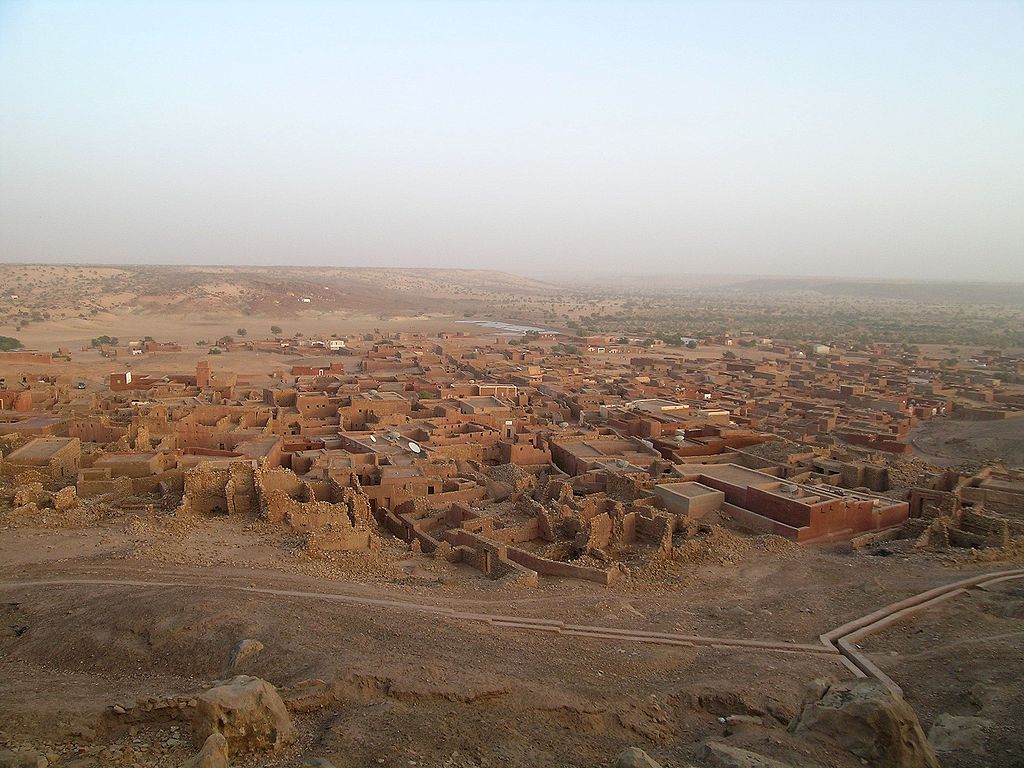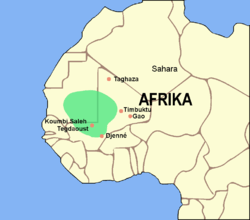Let me tell you about one of the greatest Ancient kingdoms of Africa, the Ghana Empire, a place known to its northern neighbors as the “Land of Gold“. No, I am not talking about the modern-day country of Ghana, which used to be called the Gold Coast and was named in honor of the great long-gone Ghana Empire by its first president, Kwame Nkrumah.
The Ghana Empire predates the modern-day country of Ghana by almost a millennium; it went from ca 300 to 1100 AD. It was a West African empire located in the area of present-day southeastern Mauritania, and western Mali. As you can see today, the Ghana Empire was actually located about 400 miles northwest of current Ghana, and was significantly bigger.

Its real name was Wagadou, but is known mostly by the title given to its ruler, the Ghana. It is not clear when the Ghana Empire ruling dynasty started, but explorer Muḥammad ibn Mūsā al-Khwārizmī gave us the first written records in 830, while in the 11th century the Cordoban scholar Al-Bakri traveled to the region and gave a detailed description of the kingdom. According to contemporary accounts such as those by al-Yakqubi (872 AD) al-Masudi (c. 944 AD), Ibn Hawqal (c. 977 AD), al-Biruni (c. 1036 AD), as well as Abu-Ubayd al-Bakri, the empire was a purely African kingdom, founded, and ruled by Africans, Soninke people. Ghana was said to be a sophisticated state with advanced methods of administration and taxation, large armies, large population, and lots of gold.
Its capital was Koumbi-Saleh, on the edge of the Sahara desert (when the Sahara was not as arid as today). According to the description of the town left by Al-Bakri in 1067/1068, the capital was actually two cities 10 kilometres (6 miles) apart from each other but, “between these two towns are continuous habitations“, so that they might be said to have merged into one. The king’s residence, known as El-Ghaba, was the major part of the city. It was protected by a stone wall; very similar to the Tata of Sikasso: an African Fortifying Wall. Like in many African states today, the city contained a sacred grove of trees where the priests lived. The king’s palace was the grandest structure in the city, surrounded by “domed buildings.” The other section of the city, which was the primary business district, was surrounded by wells with fresh water, where vegetables were grown. It was inhabited almost entirely by Muslims along with twelve mosques. During the time span of the Ghana Empire, Islam was introduced to the area. The king of the Soninke people who founded Ghana never fully embraced Islam, but had very good relations with Muslims.

The economy of the empire was based around gold, salt, copper, and other goods. The imports included textiles, ornaments, and other materials. Many of the handcrafted leather goods found in old Morocco also had their origins in the Ghana empire. As expected, the main center of trade was Koumbi Saleh. The introduction of the camel to the region around the 3rd century AD opened the way to increased and more efficient trans-Saharan trade. Today, Koumbi Saleh is being excavated, and many cities that were part of the Ghana Empire, such as Ouadane, Chinguetti,or Oualata, are also on the UNESCO World Heritage List.
The empire’s wealth and power made for a rich and stable economy which lasted several centuries. The Ghana Empire was very populated and had many people from outside the kingdom travel through in order to trade with those from the Kingdom of Ghana or to trade with other outsiders, making Ghana a focal point trading center. The Empire of Ghana had many trade routes, and a very well-trained military to protect them, which encouraged further safe commerce and exchanges in the region. Ghana was essentially a melting pot, spreading ideas, culture, technology and other aspects of what makes different societies what they were.
The Moorish nobleman who visited the empire in the 11th century, Al-Bakri, wrote of the king: “He sits in audience or to hear grievances against officials in a domed pavilion around which stand ten horses covered with gold-embroidered materials. Behind the king stand ten pages holding shields and swords decorated with gold, and on his right are the sons of the kings of his country wearing splendid garments and their hair plaited with gold. The governor of the city sits on the ground before the king and around him are ministers seated likewise. At the door of the pavilion are dogs of excellent pedigree that hardly ever leave the place where the king is, guarding him. Around their necks they wear collars of gold and silver studded with a number of balls of the same metals.”
Ghana appears to have had a central core region and was surrounded by vassal states. One of the earliest sources to describe Ghana, Al-Ya’qubi, writing in 889/90 (276 AH) says that “under his authority are a number of kings” which included Sama and ‘Am and so extended at least to the Niger valley. These “kings” were presumably the rulers of the territorial units often called kafu in Mandinka.
Al-Bakri mentioned that the king had officials (mazalim) who surrounded his throne when he gave justice, and these included the sons of the “kings of his country” which are presumably the same kings that al-Ya’qubi mentioned in his account nearly two hundred years earlier. Al-Bakri‘s detailed geography of the region shows that in his day, or 1067/1068, Ghana was surrounded by independent kingdoms, and Sila, one of them located on the Senegal River, was “almost a match for the king of Ghana.” Sama is the only such entity mentioned as a province, as it was in al-Ya’qubi’s day.
Eventually the Ghana Empire’s power declined. It was attacked by other kingdoms in need of their resources. The Ghana Empire eventually merged with the Mali Empire, which became one of the largest empires in African history and one of the richest as well.
To find out more, please check out these articles on BBC, and the Ghana Empire (Ancient History Encyclopedia), and the books General History of Africa, Vol. 3, Africa from the Seventh to the Eleventh Century, ed. El-Fasi, M., UNESCO (1998), Haut-Sénégal-Niger: Le Pays, les Peuples, les Langues; l’Histoire; les Civilizations. by Delafosse, Maurice (1912) in 3 Volumes, Paris, and the article The question of Ghana, Journal of the International African Institute, Mauny R., 24 (3): 200–213.







That is so fascinating. I first heard the term Wagadou when I watched the Burkinabe fantasy movie Sia, Dream of the Python which takes place centuries ago in that kingdom.
LikeLike
Pingback: Africa in the ‘middle ages’* – first readings – Oak of Honor Games
Pingback: 7Robots Fantastically Terrible Podcast ep11: African Americans changed comics
Pingback: The Ghana Empire: Great and Magnificent Ancient Kingdom of Africa | BLACK IS BEAUTIFUL!
Pingback: The Ghana Empire: Great and Magnificent Ancient Kingdom of Africa | BLACK IS BEAUTIFUL NO. 1